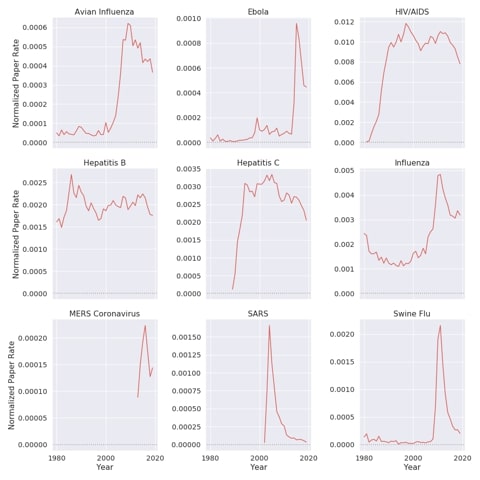Against the background of the attempts to find a vaccine against the new corona virus, data science and public health researchers reveal in a new study how the world of science too quickly abandons the occupation of previous epidemics and because of this, gaps in preparedness for the next outbreaks are created.

The short memory of the world of science: For the past two decades, scientists have studied outbreaks of worldwide epidemics, but after they subsided, research attention to these epidemics decreased in a way that harmed preparation for subsequent outbreaks - this is the disturbing picture that emerges from a new study conducted by data science and public health researchers from the university.


Dr. Michael Pierre | Photography: Danny Machlis; Prof. Kobi Moran-Gilad Photo: ESCMID
The study, which included a first-of-its-kind analysis of 200 million scientific articles, shows that in the years preceding the outbreak of the coronavirus, scientific research in the field of pandemic preparedness was not consistently conducted. "Although it was known that another outbreak was probably only a matter of time, the studies that might have helped in dealing with the corona virus were not continued," state the researchers based on the data analysis.
According to the data published in the prestigious journal GigaScience, the investment in infectious disease research has not been uniform in the last 20 years. There was a drastic decrease in the scope of research directed at emerging pathogens, whenever a particular epidemic subsided a bit. According to the findings, the research on viruses and infectious diseases reached its peak after the outbreak of these epidemics, but fell off the research agenda within only two years of the beginning of the epidemic.
The data showed that the "Sars" and "Mers" viruses from the corona virus family, accounted for only about 0.4% of all virology studies in the last 20 years. For comparison, studies on the AIDS disease accounted for about 7.9% of virology studies.
Dr. Michael Pierre and his research student Dima Kagan from the Department of Software and Information Systems Engineering, in collaboration with Prof. Kobi Moran-Gilad from the Department of Health Systems Management at the School of Public Health, and a member of the Ministry of Health's epidemic treatment team, built the innovative data set and derived the research analyzes from it. This is the first time that researchers have analyzed such a large database, which includes over 200 million articles and almost 2 million studies in the field of infectious diseases.
According to the researchers, the outbreak of the corona disease proves how little the world knew about emerging viruses. According to them, "no long-term research has been conducted on these types of infections. Such a pattern leaves us unprepared for moments of truth when an epidemic breaks out. We must continue to maintain a steady pace of research, even after the current epidemic is forgotten. The path to understanding and cracking viruses is a marathon, not a sprint."
The researchers also point out that while in all fields of medical research there has been a significant increase in the scope of research in recent years, the field of emerging infectious diseases has not shown a similar trend. It seems that the researchers mainly study the outbreaks that exist in the present and not the outbreaks that may come in the future, the researchers conclude.

In the figure: the index of the number of articles over time by disease. It can be seen that there is a sharp drop in SARS and MERS after the outbreak ended, in contrast to other diseases such as jaundice or AIDS.

One response
In my opinion, budget size and manpower are important in this case. If there was enough budget, the amount of research and working hours could be expanded, and more could be invested in the recruitment and training of personnel for research.